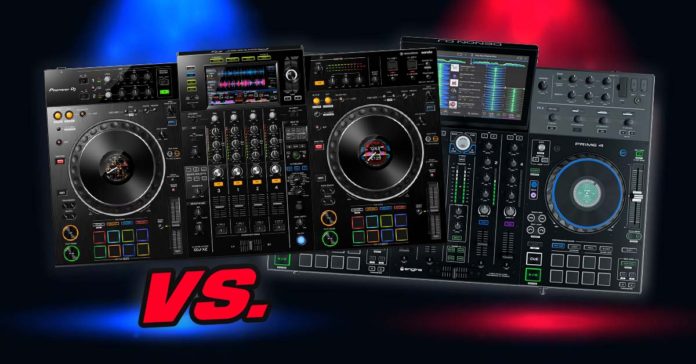Denon DJ Prime 4 vs. Pioneer XDJ-XZ. Prime 4 vs. XDJ-XZ. When it comes to high end professional standalone DJ controllers, the Pioneer XDJ-XZ and the Denon DJ Prime 4 are one of the most popular choices (alongside with the new Pioneer XDJ-RX3). Let us dive into the comparison of the XDJ-XZ and the Denon DJ Prime 4 and help you decide which one of the two would be a better choice for you.
- Main differences + control layout
- Mixer sections
- FX sections
- Performance pads
- Standalone features (!)
- Built in Wi-Fi on the Denon DJ Prime 4 + streaming services
- The touch displays
- Jog wheel differences
- Software compatibility
- Inputs & Outputs
- Zone output on the Denon DJ Prime 4
- Price and availability
- Pros and cons
- The conclusion – which one is better for you?
This web portal is reader-supported, and is a part of the Amazon Services LLC Associates Program and the eBay Partner Network. When you buy using links on our site, we may earn an affiliate commission!
Main differences + control layout
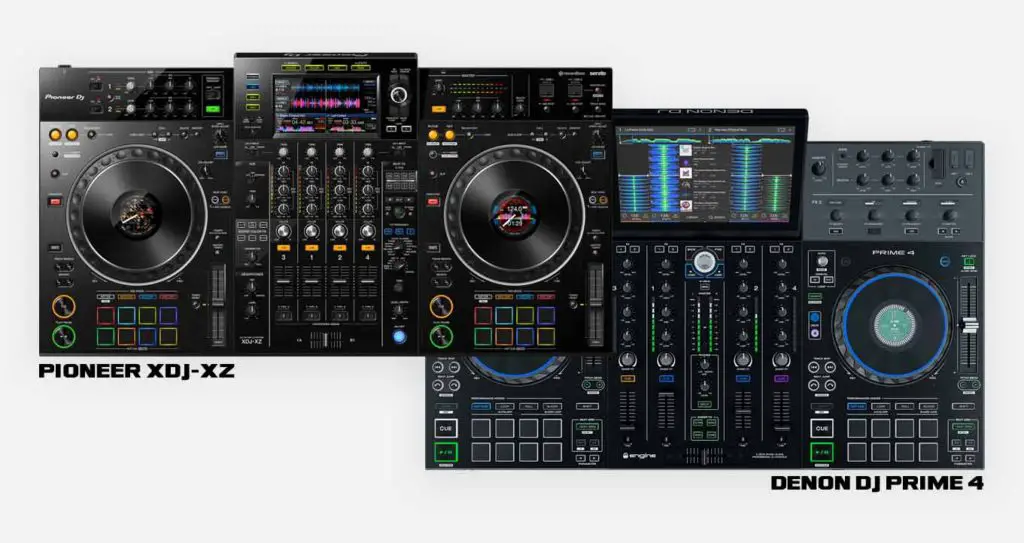
Most important differences between the Pioneer XDJ-XZ and the Denon DJ Prime 4 are:
- Better quality larger screen and more efficient UI on the Denon DJ Prime 4.
- Full size mechanical jog wheels on the Pioneer XDJ-XZ vs. smaller capacitive platters on the Denon DJ Prime 4.
- Pioneer XDJ-XZ supports only 2 mixer channels in standalone mode.
- XDJ-XZ weighs 28 lb (13 kg), while the Denon DJ Prime 4 weighs around 21.34 lb (9.67 kg).
- Denon DJ Prime 4 is also a bit smaller than the XDJ-XZ.
Pioneer DDJ-1000 vs. XDJ-XZ (New Detailed Comparison!)
Mixer sections
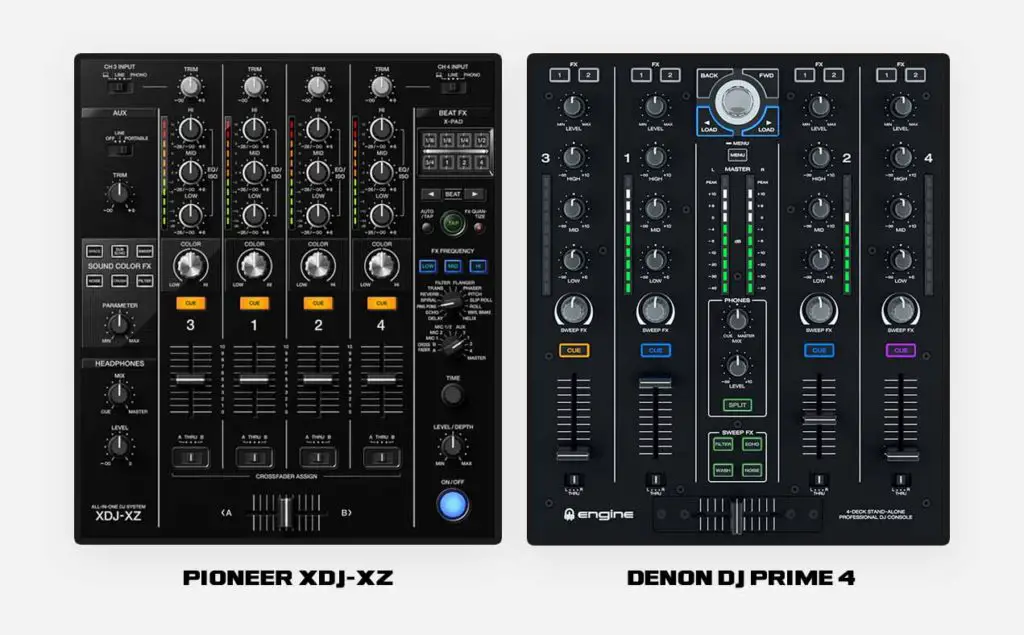
The mixer sections on both these devices are very similar in terms of functionality and layout. One major difference would be that the Denon DJ Prime features FX assign buttons over each mixer channel and doesn’t have a Beat FX strip because of the way audio FX work on this unit (more on that in a short while).
Second minor difference regarding the layout would be the placement of the master volume indicators which on the Prime 4 are located in the middle of the mixer, while on the Pioneer XDJ-XZ they can be found in the master volume & EQ control section in the top right of the controller.
Denon DJ Prime 4 also features physical buttons used for accessing the decks 3 and 4, as it allows you to utilize all 4 mixer channels in the standalone mode. Pioneer XDJ-XZ doesn’t have additional physical buttons for deck switching.
Besides the mixer section control differences, an important detail to note is that the Denon DJ Prime 4 features dedicated buttons for live beat grid edits on each deck.
FX sections
The Pioneer XDJ-XZ has its Sound Color FX and a classic Beat FX strip designed after the Pioneer DJM-900NXS2 mixer.
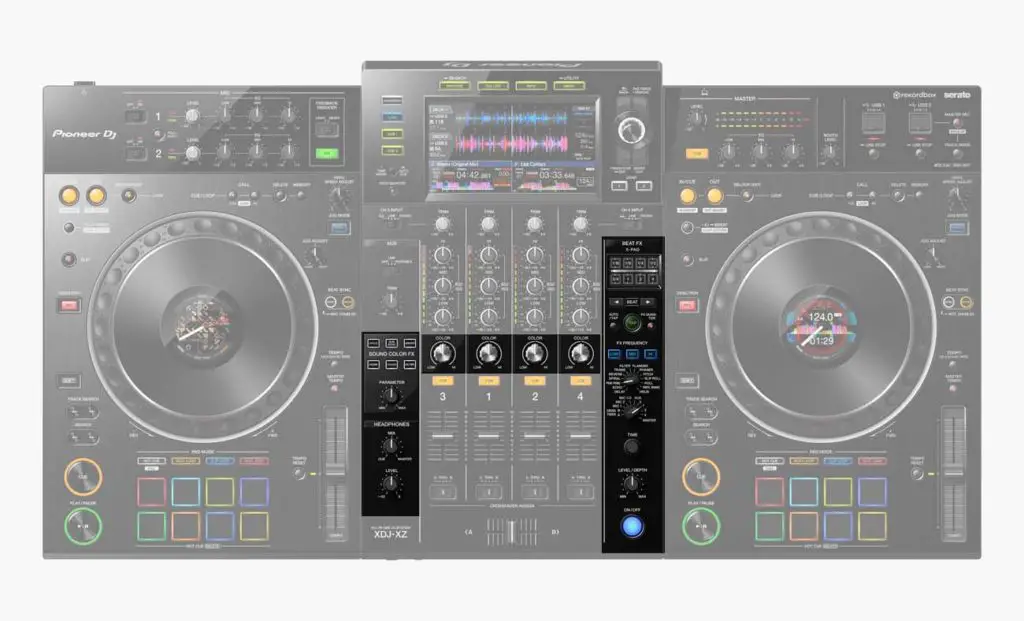
A great feature on the Pioneer XDJ-XZ is the audio FX frequency isolation control consisting of three buttons: low, mid and hi. It enables you to choose which frequencies your chosen active effect should affect. On Denon DJ Prime 4 there is no such function available.
Pioneer XDJ-RX3 Standalone DJ Controller – 7 Reasons Why You Need To Get One!
Denon DJ Prime 4 features a built in FX section that in a way resembles a classic FX control scheme made with Serato DJ controllers in mind (such as the one present on the Pioneer DDJ-SX series).
Prime 4 also has the equivalent of the Pioneer’s Sound Color FX on board – the Sweep FX which can be controlled using dedicated FX selection buttons on the mixer and the channel filter knobs.
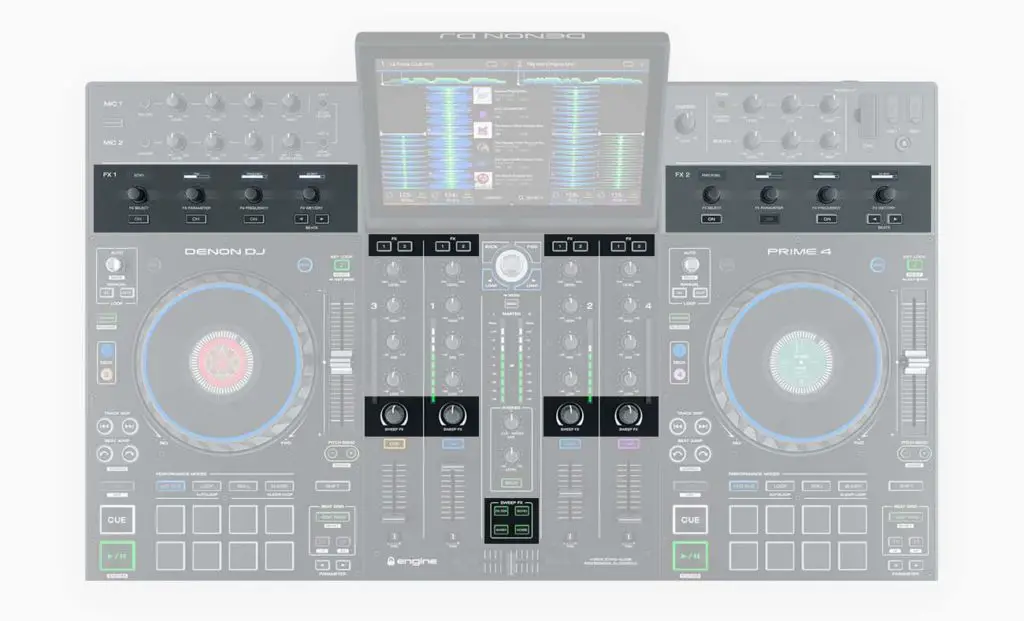
Over the FX parameter control knobs on the Denon DJ Prime (which are located on top of each deck) you can find small LCD screens that display the current active effect or parameter that is being modified. This is a really nice touch.
Because of the way the FX sections are implemented on these devices, on the Pioneer XDJ-XZ you can have up to 2 FX active at the same time (one from the Beat FX section and one from the Sound Color FX section).
On the Denon DJ Prime 4, in theory you could have up to 7 effects active on one track (2×3 effects from deck effectors and 1 from the Sound Color FX section).
- Pioneer XDJ-XZ – 6 Sound Color FX + 14 Beat FX + X-pad and EQ control
- Denon DJ Prime 4 – 4 Sweep FX + 14 Denon Beat FX
Check out the official Denon DJ Prime 4 FX demo on the official Denon DJ YouTube channel here.
Performance pads
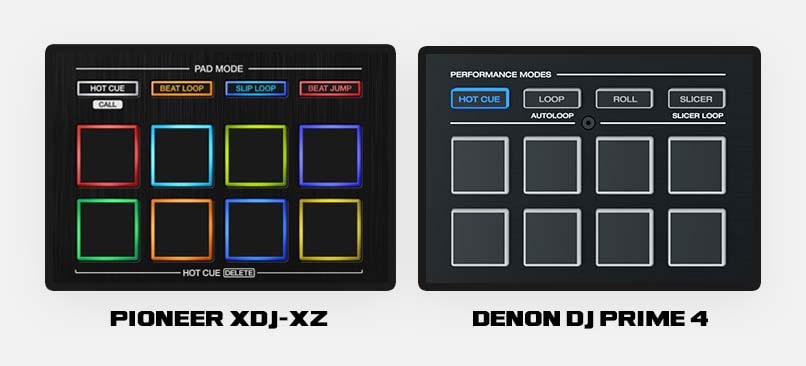
Both devices feature 8 RGB performance pads with access to following pad modes:
- Pioneer XDJ-XZ – Hot Cue, Beat Loop, Slip Loop, Beat Jump
- Denon DJ Prime 4 – Hot Cue, Loop, Roll, Slicer, Slicer Loop
Standalone features (!)
While both these devices are capable of fully standalone operation, only the Denon DJ Prime 4 lets you use all 4 channels while operating in the standalone mode. On the Pioneer XDJ-XZ you can utilize only 2 mixer channels for track playback when you’re not connected to your computer.
When it comes to audio files sources, while the Pioneer XDJ-XZ relies solely on USB devices, on the Denon DJ Prime 4 you are able to play your tracks from not only your USB devices but also SD cards and an internally mounted hard drive (Prime 4 features a drive bay on its bottom where after removing a few screws you can place a hard drive with your song library on it).
New Pioneer XDJ-RX3 vs. XDJ-RX2 (Direct comparison)
Another major thing is that on the Denon DJ Prime 4 you can freely analyze and sort your tracks on the device in standalone mode, but it’s not possible on the XDJ-XZ.
To analyze your tracks and manage your playlists on the XDJ-XZ you have to connect it to your computer, or export your tracks to a USB storage device using Rekordbox software.
Built in Wi-Fi on the Denon DJ Prime 4 + streaming services

Denon DJ Prime 4 features built-in wi-fi and it lets you utilize quite a few music streaming services, all using just by the device’s touch screen.
Pioneer XDJ-XZ on the other hand doesn’t have any kind of wireless functionality, so you aren’t able to use any kind of streaming features in standalone mode.
The touch displays

7 inch touch display featured on the Pioneer XDJ-XZ is the same screen that you might have known from the Pioneer CDJ-2000NXS players.
Sadly, the touch screen on the XDJ-XZ does not support multi touch nor on screen gestures like the Denon DJ Prime 4 does.
The 10 inch display on the Denon DJ Prime 4 is in general more pleasant to use in terms of user experience. and in our humble opitnion the UI is much better composed and more responsive than the one present on the XDJ-XZ.
The screen on the Denon DJ Prime 4 is definitely one of the strongest points of this device.
Jog wheel differences
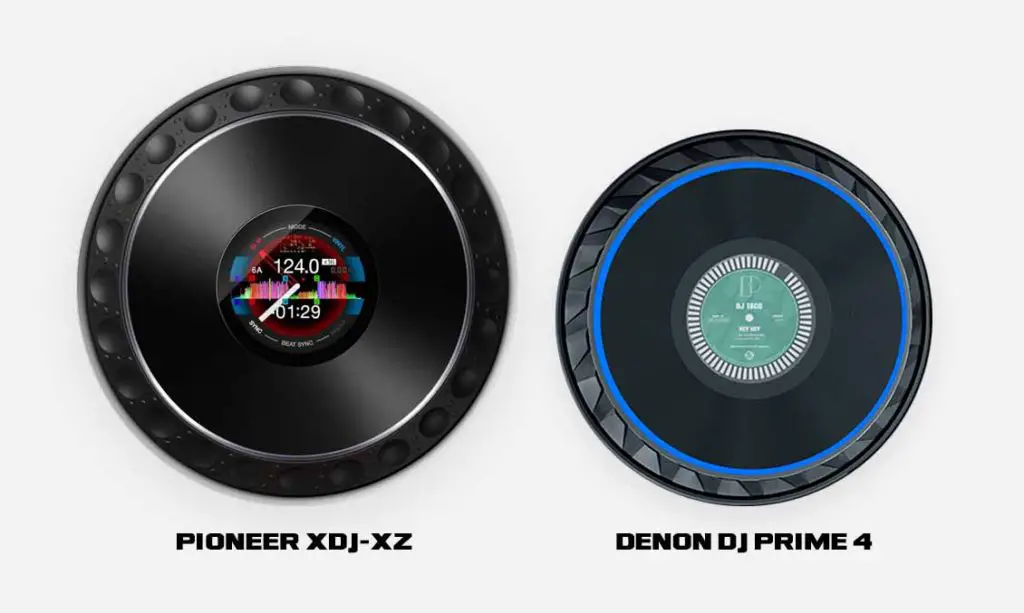
Pioneer XDJ-XZ features full-sized mechanical jog wheels (technically the same as ones present on the Pioneer CDJ-2000NXS players), and the Denon DJ Prime 4, makes use of a bit smaller capacitive platters.
The jog wheels on both Pioneer XDJ-XZ and Denon DJ Prime 4 are able to display a digital needle position indicator on their built-in LCD screens however only the XDJ-XZ you are able to additionally display basic track information on each platter.
Jog wheels on the Prime 4 also have backlit edges with customizable color schemes which is a nice touch overall.
You can freely adjust the tension of each jog wheel platter on the Pioneer XDJ-XZ using two dedicated knobs. On Denon DJ Prime 4 unfortunately, there is no jog wheel tension adjust control.
Software compatibility
In terms of software support the Pioneer XDJ-XZ unlocks full versions of both Rekordbox software and the Serato DJ Pro software while plugged into your laptop. In standalone mode it relies on its internal Pioneer DJ firmware which allows you to use the device without being plugged into a computer.
Denon DJ Prime 4 on the other hand in the standalone mode makes use of the Engine OS – a custom Denon DJ firmware that is used by standalone Denon DJ controllers.
While plugged into a computer, the Prime 4 unlocks the full version of Serato DJ Pro and is compatible with Virtual DJ software. While Denon DJ Prime 4 is not compatible with Rekordbox, in standalone mode it can easily read USB drives formated in Rekordbox.
Inputs & Outputs
XDJ-XZ inputs and outputs:
| Inputs | – 2x LINE (RCA) – 2x PHONO (RCA) – 1x AUX (RCA) – 2x MIC (XLR & 1/4 inch TRS Jack) |
|---|---|
| Other | – 3x LAN (100Base TX) – 2x USB A ports – 1x USB B port |
| Outputs | – 2x MASTER (XLR, RCA) – 1x BOOTH (1/4 inch TRS Jack) – 2x PHONES (1/4-inch stereo jack, 1/8-inch stereo mini-jack) – 1x SEND (1/4 inch TRS Jack) |
Denon DJ Prime 4 inputs and outputs:
| Inputs | – 4x LINE (RCA) – including 2x switchable LINE/PHONO – 2x MIC (XLR & 1/4 inch TRS Jack) |
|---|---|
| Other | – 4x USB (for USB drives, 5V, 1A) – 1x USB (for computer connection) – 1x Ethernet |
| Outputs | – 2x MASTER (XLR, RCA) – 1x BOOTH (XLR) – 1x ZONE (XLR) – 2x PHONES (1/4-inch stereo jack, 1/8-inch stereo mini-jack) |
While the Pioneer XDJ-XZ allows you to connect external audio devices to just mixer channels 3 and 4, the Denon DJ Prime 4 has separate audio inputs (RCA connections) for each of the 4 mixers channels.
Also an important difference to note is that the Denon DJ Prime 4 features XLR booth outputs and the Pioneer XDJ-XZ – TRS Jack booth outputs.
In terms of microphone input there are no major differences here, however note that the Pioneer XDJ-XZ has a nice additional feature on board – the anti feedback function which is not present on the Prime 4.
Moreover, on the XDJ-XZ, by using the ethernet connection, you are able to connect your Pioneer CDJ players to your device to expand your setup by two additional decks.
Zone output on the Denon DJ Prime 4
Denon DJ Prime 4 features a so-called “zone output”. This feature enables you to play an entirely different audio signal on a separate XLR output alongside with your mix already on playing on the main master output.
This means that you can perform in one room, and have another playlist playing automatically on a PA system wired in another room. Neat!

The zone output function is configured from the touch screen and it has a dedicated volume knob and equalizer knobs in the top right section of the Prime 4.
Price and availability
You can check the current prices and availability of the XDJ-XZ and the Prime 4 on Amazon using links in the following table.
| Controller | Features | Price |
|---|---|---|
| Pioneer XDJ-XZ: – Control scheme resembling a classic CDJ & DJM club layout. – 2 active standalone channels. – High quality mechanical jog wheels. | Check price on Amazon Check price on Ebay | |
| Denon DJ Prime 4: – 10 inch LCD multi touch screen. – Great FX controls. – Possibility to play tracks from SD cards + internal drive bay. – Zone output functionality | Check price on Amazon Check price on Ebay |
Pros and cons
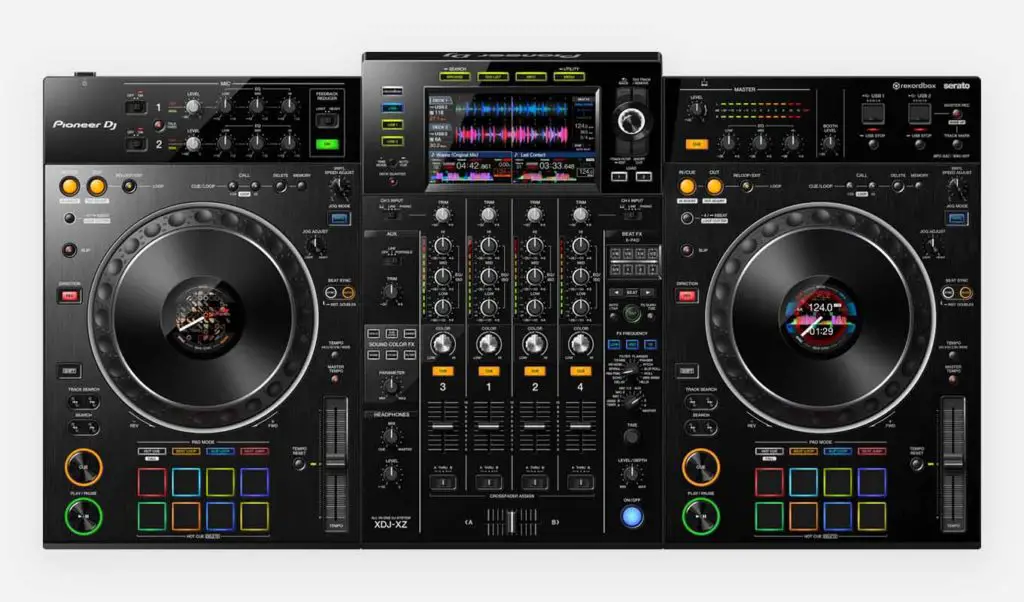
Pros:
- Great quality full sized mechanical jog wheels.
- Classic Pioneer DJ FX set.
- Feedback reducer feature for the microphone input.
- FX frequency isolator.
Cons:
- Supports only 2 mixer channels in standalone mode.
- Doesn’t have a dedicated knob for crossfader curve adjust.
- No track key controls in standalone mode.
- Cannot analyze tracks locally on the unit.
- Heavier and more bulky than the Prime 4.
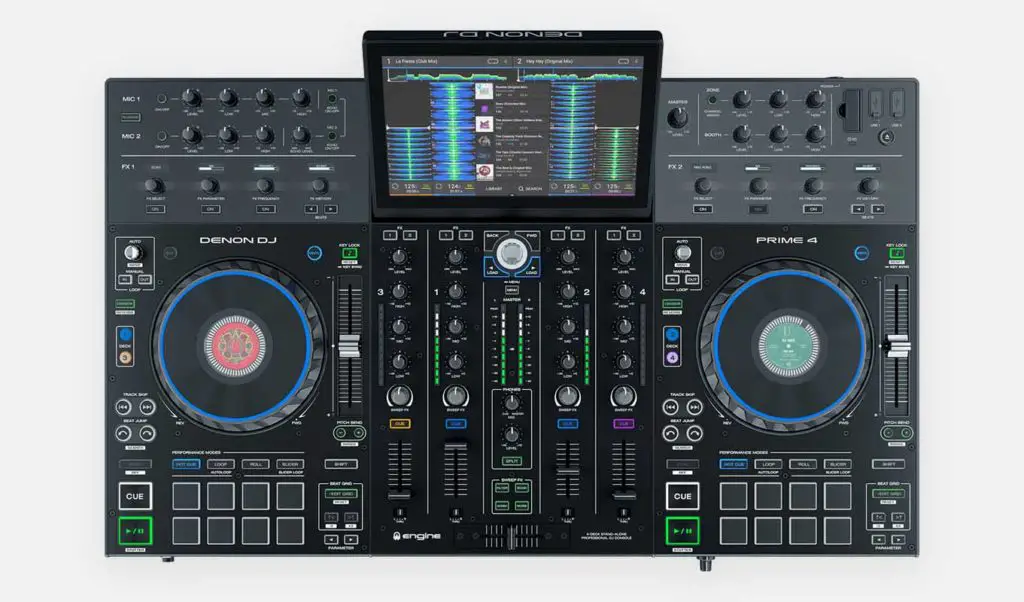
Pros:
- Full 4 channel standalone capability.
- Internal drive bay (support for drives up to 1TB).
- Overall better GUI and better quality screen.
- Possibility to pitch shift your tracks in standalone mode.
- Can analyze tracks in standalone mode.
- Has support for SD cards and for an internal hard drive.
- Zone output feature.
Cons:
- Sweep FX do not have adjustable parameters.
- No mechanical jog wheels.
- No Rekordbox software support.
| Pioneer XDJ-XZ on Ebay: |
| Denon DJ Prime 4 on Ebay: |
The conclusion – which one is better for you?
Both the Pioneer XDJ-XZ and the Denon DJ Prime 4 are top notch DJ controllers with standalone features, however when it comes to the full standalone experience and in our honest opinion the Denon DJ Prime 4 is a winner if you plan to ditch your laptop completely.
If you’re interested in other standalone controllers from Pioneer DJ, you can also check out the new Pioneer XDJ-RX3 – the newest controller from the XDJ standalone Pioneer DJ controller line, or the new product from Numark – Numark Mixstream Pro. Rock on!

